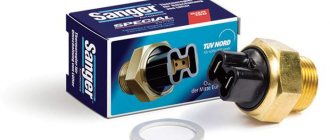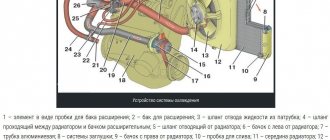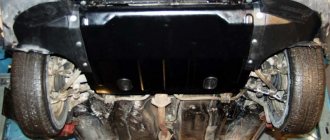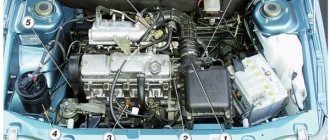Cars admin26.02.2020
Guys, tell me, when driving at first, second speed and in traffic jams, the engine temperature quickly rises to 100, 107 degrees, when driving at high speed the temperature drops to 85 - 90? This is especially noticeable now, in the spring, the weather is warm. Is this normal? phenomenon? What will it be like in the summer at plus 40 degrees? Will I overheat the engine? Thank you all in advance!
Hi all! I recently bought a Lada Priora 1.6 16 cl. 2009 with air conditioning. The car is constantly heating up, the temperature is closer to 100°. I changed the pump and timing belt, at the same time drained the entire system (the plug option is excluded, I think), the thermostat was changed, the pipes are all hot.
Tell me what the reason is.
And another question, maybe someone had! I did a full diagnosis of the injector, the result: not a single error, engine operation is smooth, system pressure is 4, the gasoline filter has been changed. But the car doesn't pull anything? What could this be, what should I do?
Thank you all in advance) I’m already thinking about selling it!
Operating temperature of VAZ 21126 Priora engines
Not only the engine life, but also a number of other performance indicators depend on the operating temperature of the VAZ 21126 gasoline injection 16-valve engine. When the operating temperature is lower or higher than the nominal one, power and dynamics are lost; the temperature affects the operation of the heater and the quality of mixture formation. And this entails indicators on fuel consumption and engine life as a whole. Today we will figure out how to change the operating temperature of the Priora, Tens and Kalina 16 valve engine, what temperature is normal and how the cooling system fan affects engine operation.
Engine temperature is below normal
Insufficient warming up negatively affects the performance of the car. When fuel comes into contact with the cold cylinder walls, it forms condensation, which enters the crankcase, diluting the engine oil.
As a result, the processes of wear of rubbing surfaces are noticeably activated (these are camshaft journals, crankshafts, intermediate shafts, liners, pistons, cylinder walls). In addition, fuel consumption increases, power and engine response are lost.
Causes
When operating a vehicle in low temperatures, you may experience engine overcooling.
This phenomenon may be caused by the following reasons:
- jamming of the open thermostat valve;
- abnormal temperature sensor, inappropriate or faulty thermostat;
- constant trips in frosty conditions over short distances;
- improper mixing of antifreeze with water;
- excessive fan cooling;
- insufficient warming up of the engine before driving.
Is there a danger if the engine temperature does not rise to operating levels?
Driving under such conditions can lead to the following adverse consequences:
- freezing of water inside the cooling system - such a situation, due to the cessation of circulation, can subsequently lead to overheating of the engine;
- disruption of the interior heating, which quickly cools down;
- freezing of the engine power system, including the spark plugs and jet.
Thus, an unheated motor can quickly fail due to increased friction.
Rated operating temperature of the VAZ 21126 Priora engine
Temperature sensor Lada Priora
This contributes to the normal correct operation of the power system, maximum engine performance, and in addition, the content of harmful substances in the exhaust gases complies with Euro3 standards that were current at that time. And the engine power, as practice shows, remains within the nameplate limits - about 98 forces at 5.5-5.6 thousand rpm. Again, judging by the reviews, and based on practice, fuel consumption during overheating can increase by 15-25%, and when operating the engine at coolant temperatures below 85 degrees, consumption increases by 10-18%.
When does the fan turn on on a VAZ 21126 and how does it affect engine performance?
Since the VAZ 21126 engine differs only slightly from the main VAZ 2110 (21124) engine, their operating temperature conditions are the same, this applies to all 16-valve VAZ engines. Another thing is that the driver in real time can assess the operating temperature conditions only by two indicators, and even then they are not very objective - this is the arrow of the liquid temperature indicator on the instrument panel and the moment the cooling system fan turns on.
Obviously, you can’t tell much by looking at the arrow; its readings are more of a symbolic nature. But the fan on Priora and VAZ 2110 operates at a clearly set coolant temperature. The fact is that the engine control system (ECM) has more accurate temperature data than the driver. These are sensors located in the cylinder block, there are two of them.
One performs a purely decorative function and is responsible for reading the temperature indicator on the tidy. The second one is the main one. Visually, it differs in that two wires are connected to it, rather than one, and it is this wire that reports the actual antifreeze temperature to the ECM. It gives the unit accurate information and sends a command to turn on the fan.
At the same time, the engine temperature drops by an average of 5-7 degrees if the Carlson is turned on at half power, and if with full load, the temperature levels out from 105-107 ˚C to a nominal 96-98 degrees, depending on the speed and temperature outside.
What is the operating temperature of a Priora 16 valve engine?
Not only the engine life, but also a number of other performance indicators depend on the operating temperature of the VAZ 21126 gasoline injection 16-valve engine. When the operating temperature is lower or higher than the nominal one, power and dynamics are lost; the temperature affects the operation of the heater and the quality of mixture formation. And this entails indicators on fuel consumption and engine life as a whole. Today we will figure out how to change the operating temperature of the Priora, Tens and Kalina 16 valve engine, what temperature is normal and how the cooling system fan affects engine operation.
Refinement of the cooling system
Domestic cars are far from perfect, that's a fact. Lada Priora was no exception in this regard, having inherited many shortcomings from the legendary “ten”. One of them is an unfinished cooling system.
There are several ways to quickly and without financial costs modify the SOD on Priora.
- Installing a 6-hole thermostat (stable maintenance of coolant temperature).
- The use of Kalina SOD on Priora will reduce the pressure in the system and provide quick warm-up at subzero temperatures.
- Installing a larger or additional water pump to improve coolant circulation efficiency.
- Use of multi-speed and silent forced cooling fan.
- Changing the firmware of the control unit so that the fan operates at a lower temperature.
Refining the cooling system of the Lada Priora is a feasible task even for novice car enthusiasts. The SOD has a simple design with a minimal set of components. Thanks to this, the system is relatively reliable.
If the operating rules are followed, the ODS does not cause problems for the car owner, but natural wear of parts is possible. Therefore, it is necessary to regularly monitor the operation of the system and, if even minor problems are identified, correct them as soon as possible.
The VAZ 2170 model received several power plants, but the most popular engine in the Priora is a gasoline unit with 16 valves and a volume of 1.6 liters. On various automotive forums it is called briefly - 126 (number). Responsible drivers spend a long time thinking about which car to buy, and the engine plays an important role in this matter. Service life, operating temperature, price of a new motor, analysis - our review will answer all these questions.
Rated operating temperature of the VAZ 21126 Priora engine
To find out what the normal operating temperature is in the Priora 16 class injection engine, just study the factory technical documentation. It says that according to the International Motor Vehicle Manufacturers Convention, the operating temperature in gasoline engines with an injection power system should be within 90 degrees. VAZ 21126 engine must operate in the temperature range from 87 to 103 degrees .
Temperature sensor Lada Priora
This contributes to the normal correct operation of the power system, maximum engine performance, and in addition, the content of harmful substances in the exhaust gases complies with Euro3 standards that were current at that time. And the engine power, as practice shows, remains within the nameplate limits - about 98 forces at 5.5-5.6 thousand rpm. Again, judging by the reviews, and based on practice, fuel consumption during overheating can increase by 15-25%, and when operating the engine at coolant temperatures below 85 degrees, consumption increases by 10-18%.
Priora engine tuning
To improve the power performance of the Priora power unit, they resort to the following modifications:
- The receiver is installed.
- Exhaust pattern: 4-2-1.
- Throttle valve: 54 -56 mm.
- Sports camshaft.
- Modification of the cylinder head (cylinder head) by sawing.
- Lightweight valves.
- 440cc type injectors.
In addition to the considered method of transforming the power unit to increase dynamic performance, there are several more ways to tune a car of this model.
Hey guys! Yesterday I went to Stavropol and discovered a problem. Previously, everything was calm, the temperature in winter and summer was consistently 84-86 degrees and the valve worked extremely rarely. I thought that this was not normal, I changed the thermostat, the result did not change. Well, I went like that. And yesterday I stopped to smoke, I didn’t turn off the car, the air conditioner was working, as soon as the on-board vehicle started to move, the staff began to squeak about a possible overheating of the engine, the temperature on it showed 110 degrees. I compared it with the tidy - exactly 110. I can’t hear the valve (I don’t know if it was working). I drove slowly and went down the hill at idle, the temperature dropped to 96. Well, then it stayed in the range of 95-102. Once it jumped to 104 in a traffic jam on the way up and again dropped to 95-96. I arrived at my destination, checked the antifreeze - the level was normal, the plug was normal (no traces of rust, I recently changed it), I moved all the chips. In the on-board vehicle, I changed the valve response temperature from 105 to 102 (some crap, it doesn’t even seem to change anything). All the time the engine reached 102 degrees, turned on the valve and cooled down. In general, as a result, now when driving around the city (and at night too), the temperature is constantly in the range of 96-102, the valve is constantly almost threshing. Actually the question is: what the hell? Is this normal? Or what to watch? Thanks in advance. I completely forgot, it was all in the morning at about 10 o’clock, the air temperature outside was 32 degrees...
Comments 43
Her operating temperature is 102
It’s amazing to see the great minds dispensing advice here.
Guys, I conducted further investigation, so to speak. The pump is working properly, I checked the pressure from a thin tube to the expansion tank, at high speeds, the stream steadily gains pressure. I checked the thermostat by touch, at 85 it starts to open, I don’t know when it’s fully open, but at 102 degrees both thick hoses are hot. The plug holds the pressure, after a long time I turned off the engine and unscrewed the plug, it sputtered normally. By the way, the pump is a luzar, I didn’t want to install it. Fans in general, you’ll understand how they work, just now I looked with the air conditioner on, it heated up to 102, both valves turned on all the way and threshed right up to 87 degrees. Then he turned off the condenser and began to heat it further, heated it up to 103 (!) degrees, both turned on again and again fully, the engine continued to heat up to 105 degrees and dropped sharply to 99, at that moment the fans stopped and started again, dropping the temperature to 95 and turned off fully. In short, I’m generally at a loss as to what to do. What haunts me is that then, for the first time, the temperature rose to 110.
Priora temperature sensor. How to check
Consequently, all responsibility for turning on the fan, and, consequently, adjusting the operating temperature, lies with the sensor. Its design is simple. This is an ordinary temperature sensor, which, when the temperature changes, changes the strength of the supplied response pulse. This is what the characteristics of the engine temperature sensor for VAZ 21126 Priora and Kalina look like:
Liquid temperature, °C
Naturally, as the temperature changes, the sensor voltage will also change.
Liquid temperature, °C
Method for checking the fan switching temperature sensor of Priora, Kalina, VAZ 2110
Therefore, if you have a multimeter in your hands and some skills in working with it, you can easily check the temperature sensor. To do this, you need to know to what temperature it is heated (which is easy to find out with a simple thermometer), and take the readings of a multimeter. Now the question of how to find out the temperature at which the fan turns on on Priora, Kalina and VAZ 2110 with a 16-valve VAZ 21126 engine disappears, and you can also draw a simple conclusion.
Once the antifreeze temperature reaches 110˚C, the sensor resistance is about 133 ohms. At the same time, the ECM sends a signal to turn on the fan. When the sensor resistance is about 188 Ohms at a temperature of 97-98 °C, the fan automatically turns off.
Schematic diagram of connecting the fan switch sensor
Thus, we have found out the principle of operation of the cooling system fan of Priora and Kalina cars with a 16-valve VAZ 21126 engine, as well as indications of the normal temperature in the cooling system.
A car engine is equipped with a cooling system that contains liquid. The temperature of this liquid is measured by a sensor. This value that it records is the engine operating temperature (ERT). The data recorded by the sensor is displayed on the dashboard. The average operating temperature of a Priora car engine is 95 degrees. This indicator is optimal when the car is moving at a speed of approximately 70-80 km/h and provided that the ambient temperature is not higher than +20 degrees. When the liquid heats up to 100 degrees, the fan turns on, which is designed for additional cooling. With such indicators, it is time to say that the power plant of the machine is functioning without failures. In winter and summer, the RTD may be different. Which RTD is considered optimal for this car? The average is 85-90 degrees.
If the fan does not turn on
If the RTD has risen to 100 degrees and the indicator needle has entered the red part of the scale, this indicates overheating. Perhaps this phenomenon occurred due to the fact that the fan did not work. If you find that when it overheats, the fan does not start working and the temperature does not drop, you need to check the serviceability of the fan itself. It is necessary to determine whether the switch-on sensor is triggered when the normal RTD is exceeded? First, start the engine and disconnect the wires from the temperature sensor that is installed on the engine. When the wires are disconnected, forced cooling should work. If this does not happen, most likely the fault lies in the electric motor of the device. How to check the operation of the fan, watch the video.
If the fan turns on after disconnecting the wires, it means there is a problem with the fan switch sensor. Perhaps it incorrectly perceives data about the RTD and therefore does not operate at the right time.
This malfunction is quite easy to fix: you just need to replace the sensor. After replacing it, check if the fan turns on. To do this, start the engine. When the RTD reaches normal levels, do not turn off the engine until the temperature exceeds the norm. As soon as this happens, the fan should be activated. If the fan operates at a temperature above 97 degrees, but less than 100 degrees, then the system is functioning properly.
Are the valves bent?
Each engine in a Lada Priora car bends a valve, this also applies to the most powerful unit number 126 by 16. They will tell you this in any service center that services domestic cars. But novice drivers should know that the engine bends components for a reason, and if you follow the operating rules, you will not encounter this problem.
The Lada power plant bends parts only if the routine work to replace the belt and other components of the gas distribution mechanism (GRM) is violated. The motor bends the valve if the rollers, belt or water pump were not replaced in time. When one of these elements breaks, the number 126 pistons meet the valves. Due to this design feature, the motor bends the parts. The solution to the problem is a major overhaul of the Lada.
see also
So, the task of the owner of a Lada Priora with engine number 126 for 16 cl is to check the timing belt in a timely manner.
The condition of the belt should be checked every 50 thousand kilometers (according to the factory recommendations - 100 thousand) - there should be no cracks, delaminations, or breaks on it. If they are present, the belt must be changed urgently. Mandatory repairs take place after 200 thousand kilometers.
The rollers and timing pump number 126 should also be given attention when inspecting the belt. After all, the engine bends parts even with faulty rollers. Sometimes the timing belt and its components wear out prematurely - you will know this by vibrations from the engine compartment and an unpleasant grinding noise. Engine number 126 bends the valve, so do not forget to change the timing components in time and repair this unit.
Temperature sensor malfunction
The reason that the liquid in the cooling system, which serves as an air conditioner for the car's power plant, does not heat up or overheats is due to the failure of the temperature sensor.
Often signs of such a malfunction are:
Many drivers quickly stop the car when it overheats and turn off the engine. In fact, an immediate stop of the machine is required only if the tightness of the system is broken and liquid pours out of it
out. In other situations, the driver must perform the following actions:
What does overheating mean?
Too high an engine temperature can be caused by breakdowns of the cooling system elements or contamination of its jacket.
Why does the temperature rise
The most common problem can be considered a lack of coolant, which should effectively remove heat from very hot parts. In such situations, it is better to add antifreeze. If this is not possible, then it is recommended to turn on the interior heating to remove excess heat.
The problem may occur due to a breakdown of the electric fan. Here the contacts may oxidize, the relay may burn out, or the sensor may break. For diagnostics, you can remove the connectors from the fan and connect them directly to the battery.
The engine temperature may increase due to a thermostat failure when the coolant circulates only in a small circle inside the engine itself. Overheating can also occur due to a clogged cooling system, a breakdown of the cylinder head gasket, or improper closing of the radiator shutters in warm weather.
Possible consequences
If overheated, the engine may seize. This is caused by boiling and evaporation of the coolant. For this reason, the metal expands, the parts are deformed, changing the normal dimensions and shape of the parts that move.
The maximum heating level is determined by the type and properties of antifreeze. In addition, due to overheating, the radiator may collapse and electrical wiring may melt.
DTOZH for the pointer on the instrument panel
The operating principle of this sensor is to change the resistance when the internal element heats up. Passing through the indicator on the instrument panel, the current flows through a single wire to the device. And here the principle of induction in coils comes into play. Simply put, the higher the resistance, the more the needle on the indicator rises, due to the circulating currents in the coil located inside the indicator.
Possible malfunctions of the Priora coolant temperature display system
Most motorists, having discovered that the engine temperature gauge needle does not rise, believe that it is necessary to change the sensor. However, you should first make sure that this is the case. After all, there are several reasons for this state of the panel:
Therefore, it is better to conduct a small check on your own.
Location and serviceability check of DTOZH
This device is located directly above the Priora flywheel housing. The sensor is embedded in the engine block near the thermostat. It is connected to a single wire with a female connector. The test method for this device is very simple. And it has been used by drivers for a very long time. You need to do this:
If the DTOZH itself is faulty, the indicator arrow will rise to its highest position. But if no changes occur on the instrument panel, then the reason must be looked for elsewhere. Maybe the circuit is broken, the pointer is broken, or the whole combination.
How to replace the Priora coolant temperature sensor
This is a fairly simple operation. It is available to any driver.
Important! Many believe that this requires draining the coolant. But this is not necessary if you act quickly and skillfully. Otherwise, it’s better to drain it anyway. So. Just in case, drain the antifreeze. To do this, unscrew the cap in the radiator. It is located near the generator, below. And a plug-bolt in the engine block. First place the container under the bottom.
Lada Priora (2019). Engine temperature drops while driving
If the thermostat cannot close all the way, allowing the fluid to continuously circulate in a large circle, the engine will not warm up to its operating temperature.
Sometimes the thermostat gets stuck after the engine has warmed up. When this happens, the driver may notice that the engine temperature drops while driving, although it should be maintained at a consistently even, operating level.
Sometimes the temperature regime changes abruptly, sometimes increases, sometimes decreases sharply. This means that the valve periodically jams, and the driver will notice a situation where the temperature arrow periodically drops.
There are other technical reasons that affect the underheating of a car’s power unit:
Fan malfunction. This electrical element should turn on only when the control unit gives it a special command based on the readings of temperature sensors. Failures in the coordinated operation of the system can lead to the fan operating in constant mode, or starting to function even when it is not necessary. Sometimes even the sensor turns out to have nothing to do with it, and the rotation of the blades causes a normal wiring short circuit. Problems with viscous couplings are also common. They are typical for models that have a longitudinally mounted motor, the fan of which bases its operation on a special device - an electronic clutch. Its jamming will not allow the element to turn off, and the car engine will not be able to warm up to operating levels.
While driving, the temperature needle drops. Natural causes
Yes, this option is also allowed by specialized specialists. Even if there are no malfunctions in the operation of the vehicle systems, the indicator needle may still fall while driving. Similar situations occur in winter, when the air temperature drops to low values. For example, when driving on country roads in severe frost, the driver may notice significant cooling of the engine. The fact is that the flow of icy air entering the engine compartment can exceed the heating intensity of the engine. At an average speed of 90-100 km/h, which is optimal for most car models, a minimum amount of fuel burns inside the cylinders.
The relationship between these factors is direct: the less fuel ignites in the combustion chambers, the slower the internal combustion engine will warm up. If we add to this the forced cooling that occurs from the oncoming air flow, the engine may not only not heat up, but even significantly reduce its temperature in the event of preheating.
How does the heater affect the engine temperature gauge?
The inclusion and constant operation of the cabin heater has no less a strong impact than malfunctions or frost. It is especially noticeable on small cars and models equipped with medium-sized engines. The situation is also typical for diesel engines, which not only do not warm up well at idle, but also cool down quickly when driving with insufficient intensity.
The car heater has a special radiator, which is included in the general operating circuit of the cooling system. When the driver turns on the interior heating, antifreeze passes through it, giving off some of the heat. The amount that will be given depends on the set temperature of the heater and its operating mode. The higher these indicators are, the more the interior of the car will heat up. If the engine operates at low speeds, and is also used in winter, there may simply not be enough heat to fully warm up the coolant. In such a situation, the engine will not reach its operating temperature.
Characteristics and features of DTOZH on Priora
Many motorists confuse the DTOZH with a cabin or ambient temperature sensor, but this is completely wrong. The purpose of the DTOZH is to monitor the temperature of the refrigerant in the cooling system.
There are two regulators in Lada Priora cars:
As for the principle of operation, it is as follows. The main regulator is located in the thermostat housing, which allows for the highest pulse accuracy. Since the DTOZH in any case comes into contact with consumables, that is, antifreeze, it instantly detects changes in temperature and sends corresponding signals to the ECU. The latter, based on the information received, adjusts the operation of the engine and changes the composition of the air-fuel mixture. If there is no or too low level of consumable fluid in the system, the controller will provide incorrect data.
Features of cooling system malfunctions
The efficiency of the structure primarily depends on the level of antifreeze in the system and its condition (this liquid has a certain resource, usually up to three years or up to 50,000 km). The main sources of system malfunctions are the thermostat, radiator and electric fan, as well as the water pump, the principle of operation of which is described above.
The radiator most often becomes the source of antifreeze leakage. Accordingly, the liquid level in the system drops, and there is not enough of it for effective heat removal. The motor begins to overheat. It can also be clogged with garbage. And if water is used instead of antifreeze the old fashioned way, scale may form.
When does the fan turn on on a VAZ 21126 and how does it affect engine performance?
Since the VAZ 21126 engine differs only slightly from the main VAZ 2110 (21124) engine, their operating temperature conditions are the same, this applies to all 16-valve VAZ engines. Another thing is that the driver in real time can assess the operating temperature conditions only by two indicators, and even then they are not very objective - this is the arrow of the liquid temperature indicator on the instrument panel and the moment the cooling system fan turns on.
Location of the temperature sensor, this sensor only works on the indicator on the dashboard
Obviously, you can’t tell much by looking at the arrow; its readings are more of a symbolic nature. But the fan on Priora and VAZ 2110 operates at a clearly set coolant temperature. The fact is that the engine control system (ECM) has more accurate temperature data than the driver. These are sensors located in the cylinder block, there are two of them.
One performs a purely decorative function and is responsible for reading the temperature indicator on the tidy. The second one is the main one. Visually, it differs in that two wires are connected to it, rather than one, and it is this wire that reports the actual antifreeze temperature to the ECM. It gives the unit accurate information and sends a command to turn on the fan.
The fan switch sensor is located near the thermostat, above the temperature indicator sensor
At the same time, the engine temperature drops by an average of 5-7 degrees if the Carlson is turned on at half power, and if with full load, the temperature levels out from 105-107 ˚C to a nominal 96-98 degrees, depending on the speed and temperature outside.











